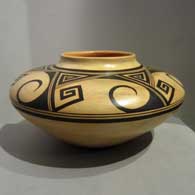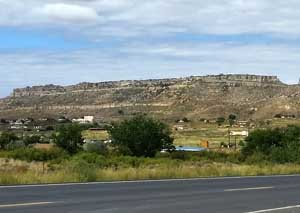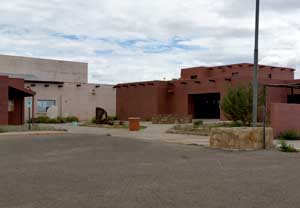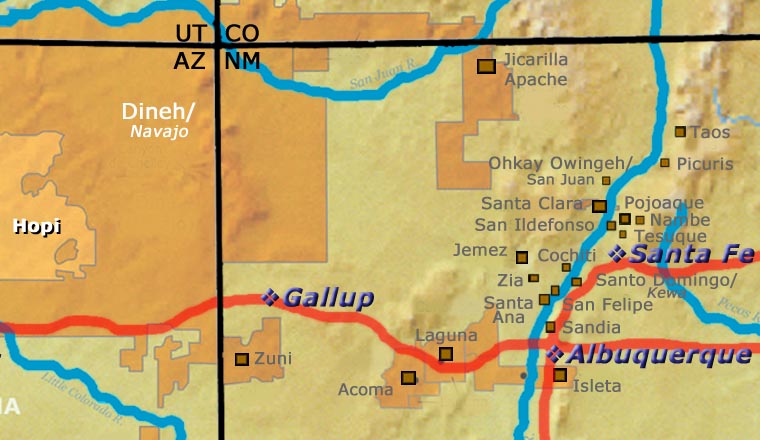
Les Namingha
Hopi and Zuni
Les Namingha was born in 1967 at Zuni Pueblo. His mother, Irene Vicenti, was Zuni and his father, Emerson Namingha, Jr. was Hopi-Tewa (the son of Rachel Namingha Nampeyo). Les learned early in life how to blend traditions and influences. At the age of eleven he went to live with a host family in Salt Lake City, UT, during the school year and spent the summers at his mother's home at Zuni Pueblo. That continued until he finished high school in 1985. From high school he went to Brigham Young University and earned his BFA in Design in 1992.
While in college, Les spent summers at his aunt Dextra's at Hopi, learning the basic methods and cultural traditions of making Hopi pottery from her. What he learned in the academic setting combined with what he learned from Dextra has helped him to develop his own potting style with its unique blend of Hopi and Zuni shapes and designs. He began participating in Santa Fe Indian Market as a potter in 1992, earning Best of Division in both traditional and non-traditional pottery and a Best of Class award in pottery in 1997.
Though he's highly accomplished in traditional Hopi ceramics, Les continues to challenge himself in new directions of thought and expression. He plays at the intersection of traditional and contemporary in all his shapes and designs. With his pottery, this blend is manifest in the Hopi-Tewa and Zuni motifs and patterns that he renders in the prehistoric way through his contemporary eye.
Les signs his work: "LES NAMiNGHA" and sometimes adds the year.
Some Exhibits that Featured Pieces by Les
- Place, Nations, Generations, Beings: 200 Years of Indigenous North American Art. Yale University Art Gallery. New Haven, Connecticut. November 1, 2019 - June 21, 2020
- What's New in New: Selections from the Carol Warren Collection. Lloyd Kiva New Gallery, Museum of Indian Arts and Culture. Santa Fe, New Mexico. June 3, 2018 - February 26, 2019. Note: exhibiting works include art by artists Tony Abeyta, Autumn Borts-Medlock, Preston Duwyenie, Tammy Garcia, Dan Namingha, Les Namingha, Jody Naranjo, Roxanne Swentzell, and Tito Naranjo
- Catch 22: Paradox on Paper. Ralph T. Coe Foundation for the Arts. Santa Fe, New Mexico. August 12, 2017 - March 31, 2018. Note: group show curated by Nina Sanders and based on the Edward J. Guarino Collection
- Les Namingha: New Painting. Blue Rain Gallery, Railyard Arts District. Santa Fe, New Mexico. August 17, 2016 - August 21, 2016
- Unrivaled: Clay. King Galleries & Virgil Ortiz. Santa Fe, New Mexico. August 19, 2016
- Elegance from Earth: Hopi Pottery. Heard Museum. Phoenix, Arizona. March 24, 2012 - April 6, 2014
- Choices and Change: American Indian Artists in the Southwest. Heard Museum North. Scottsdale, AZ. 2007
- Our Stories: American Indian Art and Culture in Arizona. Heard Museum West. Surprise, AZ. 2006
- The Collecting Passions of Dennis and Janis Lyon. Heard Museum. Phoenix, AZ. May 2004 - September 2004
- Every Picture Tells a Story. Heard Museum. Phoenix, AZ. 2002
- Indian Market: New Directions in Southwestern Native American Pottery. Peabody Essex Museum. Salem, MA. November 16, 2001 - March 17, 2002
- Hold Everything! Masterworks of Basketry and Pottery from the Heard Museum. Heard Museum. Phoenix, AZ. November 1, 2001 - March 10, 2002
- Blue Rain Gallery 2000. Blue Rain Gallery. Fort Mason, San Francisco, CA. March 24, 2000 - March 26, 2000
- Blue Rain Gallery. Ellipse Arts Center, Arlington, VA. March 26, 1999 - March 28, 1999
- 14th Annual Phoenix Indian Center Bola Tie Dinner and Awards Banquet. Phoenix Indian Center. Phoenix, AZ. Collectors Choice Artist. April 4, 1997 - April 6, 1997
- Succeeding Generations. Faust Gallery. Scottsdale, AZ. 1997
Some of the Awards Les has Won
- 2013 Heard Museum Guild Indian Fair & Market, classification II - Pottery, Div F - Non-traditional Design or Form with Non-Native Materials: First Place
- 1999 Santa Fe Indian Market. Santa Fe, NM. Class. II - Pottery, Div H - Non-traditional pottery, Best of Division;
- Cat. 1504 - Jars and vases, First Place, Second Place - 1998 Santa Fe Indian Market, Classification II - Pottery, Division E - Traditional Pottery Jars, Category 1207 - Jars, Zuni: First Place
- 1998 Heard Museum Guild Indian Fair & Market: Judges Choice Award
- 1997 Santa Fe Indian Market. Santa Fe, NM. Challenge Award in Non-traditional painting, drawing and graphics.
Class. II - Pottery, Best of Classification;
- Div. E - Traditional pottery, jars, painted designs on matte or semi-matte surface, Best of Division
- Cat. 1207, First Place - 1997 Heard Museum Guild Indian Fair & Market. Heard Museum. Phoenix, AZ. Class. VII - Pottery, Div. A - Traditional native clay/hand-built/painted, Honorable Mention
- 1994 Santa Fe Indian Market. Santa Fe, NM. Class. II - Pottery, Div. F - Traditional pottery, painted designs on matte or semi-matte surface jars, Cat. 1301 - Jars, Hopi (up to 9" tall), Second Place;
- Div. G - Traditional pottery, painted designs on matte or semi-matte surface - all forms except jars, Cat. 1404 - Other bowl forms (over 9" in diameter), First Place - 1993 Santa Fe Indian Market. Santa Fe, NM. Class. II - Pottery, Div. G - Traditional pottery, painted designs on matte or semi-matte surface, Cat. 1403 - Other bowl forms up to 9" in diameter, Second Place
100 West San Francisco Street, Santa Fe, New Mexico 87501
(505) 986-1234 - www.andreafisherpottery.com - All Rights Reserved

Hopi

Tewa Village and First Mesa
The Hopi people live in villages on or around three mesas in northeastern Arizona. Some of these villages have been continuously occupied since the 12th century. The Hopi are not so much a "people" as a collection of clans that came together in times of drought and other misfortune. The Hopi mesas have long been seen as sanctuaries. As a result, the landscape around First Mesa is littered with the remains of villages once founded by people belonging to similar clans but speaking many different languages.
As a result, the Hopi pottery tradition is also quite varied with roots traced as far away as vitrified ceramics found in the environs of Valdivia, Ecuador, and produced between 1200 and 1500 BCE. Archaeologists excavating in the abandoned pueblos around First Mesa also found sherds of pottery styles and painted designs found in the Rio Salado region and among the ancient Sinagua settlements in the Wupatki, Tuzigoot, Walnut Canyon and Homol'ovi areas (all abandoned between about 950 and 1250 CE).
The area around Jeddito was occupied by Towa-speaking people beginning in the late 1200s. The Jeddito area is where Jeddito yellow is found, the clay that made the pottery of Sikyátki so spectacular. Beginning in the 1200s, Keres-speaking people arriving from the east began to build what became Awat'ovi, on Antelope Mesa between Jeddito and First Mesa. Sikyátki itself was also built by people from the east beginning in the early 1300s. At first Sikyátki was inhabited solely by the Kokop (Firewood) clan, then the Coyote clan came and grew to become the largest single clan in the village. Why the village was destroyed is shadowed in myth but Jesse Walter Fewkes (the first archaeologist to excavate in the area) felt the village was destroyed before the first Spanish visitor arrived in 1540. Oral history has it that Sikyátki and its people were completely wiped out but the clans that inhabited that village have somehow continued to exist. Modern dating techniques have set the destruction of Sikyátki around 1625.

The Hopi Cultural Center
The ruins at Awat'ovi (on Antelope Mesa, east of Walpi and south of Keams Canyon) have yielded potsherds in styles and with designs that were also prominent in the prehistoric village now known as Pottery Mound (in central New Mexico). Among the potsherds found at Pottery Mound are plain and decorated Hopi products, white clay products from the Acoma-Zuni area and red clay products from north-central New Mexico. Pottery Mound was abandoned about 100 years before the Spanish arrived in New Mexico in 1540. Also similar to Pottery Mound, Awat'ovi had several kivas painted with layers of wall murals, each painted on top of the whitewashed last.
It has been reported that many of the residents of Awat'ovi were Keres-speaking people from the Four Corners area and were not as resistant as other Hopis were to the Christianizing practices of the Spanish Franciscan monks when they came into the Hopi lands around 1609. As Awat'ovi was the only pueblo in the Hopi region where a Christian mission was built, most archaeologists attribute that to the reason why residents of Walpi and Old Oraibi destroyed the village and killed nearly all its residents in the winter of 1700-1701. However, at the time of that destruction, Awat'ovi was the largest and most populous pueblo in the Hopi mesas. It was also around 1690 that the people of Walpi were relocating from their old pueblo at the foot of First Mesa to their new location atop the southernmost finger of First Mesa, a move made for defensive reasons. This was after the Pueblo Revolt of 1680 and everyone was expecting the hated Spanish to return, with more soldiers and priests.
Southern Tewa warriors and their families began arriving in the area in 1696 and were steered to take up residence at the foot of First Mesa, along the only route to the mesa top (in that location, the Tewas would be the first people to encounter incoming Spanish military - the people of Walpi felt they would make a good first line of defense should the Spanish attempt to reconquer them). The Tewas were also good at repulsing Ute, Paiute and Navajo raiders. After they won a decisive battle with Ute raiders they were allowed to build Tewa Village (also known as Hano) at the gap between the rocks on the trail up First Mesa. Some of the Tewa women were potters and in the ages-old way, they slowly shared what they knew with Hopi potters, and vice versa. That cross-pollination went on for years, and not just with pottery. Cross-cultural marriages happened, too, and today the people are known as Hopi, Hopi-Tewa and Tewa, depending on their ancestry. And while Tewa Village is completely surrounded by the Hopi Reservation, many of the residents are fluent in Tewa, Hopi and English. Some are fluent in Spanish and Navajo, too. There is a tribal injunction against any Hopi speaking Tewa: they may understand what is being spoken in Tewa but they are not allowed to speak Tewa themselves.
During those same troubled times Towa-speaking people migrated into Hopi and Navajo territory (primarily in the Jeddito Wash area) to escape the violence of the Spanish reconquest. They established familial ties that are still in place today (which may explain why Jeddito Wash is a Navajo Reservation island surrounded by the Hopi Reservation).
The village of Sichomovi was founded in the 1600s by members of the Wild Mustard Clan, Roadrunner Clan and others who'd come to the area from east of Santa Fe (Pecos Pueblo and the pueblos of the Galisteo Basin) via Zuni. They seem to have stopped at Zuni for a few years and assimilated somewhat. When they moved on to Hopi, there were quite a few Zunis among them, that's why the people of Walpi (and some from Zuni) refer to Sichomovi as a Zuni pueblo.
They arrived at Hopi around 1600 CE and became known as the Asa clan. They had traveled from the Abiquiu area through Santo Domingo, Acoma, Laguna and Zuni, picking up and dropping off people, technology and social practices along the way. Some settled at Awat'ovi while others continued to Coyote Spring (under the gap at First Mesa). They built a new pueblo where Hano now stands (it was known as Hano back then, too). A few years later drought and disease caused them to relocate again.
The quality, styles and designs of Sikyátki had lived on in Awat'ovi pottery, although the potters of Awat'ovi were also enamored of using a white slip on top of the Jeddito clay base. The potters of Awat'ovi also introduced some new designs (the "Awat'ovi star" being one) but after the village was destroyed, very little of their knowledge and practice passed on. Hopi ceramics entered a virtual Dark Age for almost 200 years.
By the mid-1800s the Hopi pottery tradition had been almost completely abandoned, its utilitarian purposes being taken over by cheap enamelware brought in by Anglo traders. Hopi pottery production sputtered along until the late 1800s when one woman, Nampeyo of Hano, almost single-handedly revived it. Nampeyo lived in Tewa Village by First Mesa and was inspired by potsherds found among the nearby ruins of Sikyátki. Today credit is given to Nampeyo for fully reviving the Sikyátki style. She was so good that Jesse Walter Fewkes, the first archaeologist to formally excavate Sikyátki, was concerned that her creations would shortly become confused with those made hundreds of years previously.
Sikyátki pottery shapes are very distinctive: flattened jars with wide shoulders; low, open bowls decorated inside; seed jars with small openings and flat tops; painting methods of splattering and stippling and very distinctive designs. The Sikyátki style originally evolved when migrant Keres and Towa-speaking potters got together with migrant Water Clan potters from the Hohokam areas of southern Arizona and northern Mexico and they began working with clays found in the Jeddito area. Over the years other clans came to the area and made their own contributions to what we now know as "Sikyátki Polychrome." Accoding to Jesse Walter Fewkes, that merging of styles, techniques and designs created some of the finest ceramics ever produced in prehistoric North America.
Today's Hopi pottery tends to be a white, yellow, orange or buff colored background decorated with designs in red and black mineral paints. Painted designs sometimes fill the entire space, often with an asymmetrical and symmetrical design. Most of the symbology painted on Hopi pottery is themed with "bird elements:" eagle tails, feathers, bird wings and migration patterns. Many Hopi, Hopi-Tewa and Tewa potters are members of the Corn Clan and their annual religious cycle revolves around the seasons of corn. The vast majority of today's Hopi pottery shapes and the designs painted on them are obvious descendants of the work of Sikyátki and Awat'ovi potters.
100 West San Francisco Street, Santa Fe, New Mexico 87501
(505) 986-1234 - www.andreafisherpottery.com - All Rights Reserved

Nampeyo of Hano Family Tree
Disclaimer: This "family tree" is a best effort on our part to determine who the potters are in this family and arrange them in a generational order. The general information available is questionable so we have tried to show each of these diagrams to living members of each family to get their input and approval, too. This diagram is subject to change should we get better info.
-
Nampeyo of Hano (c. 1859-1942) & Lesou (c. 1860-1942)
- Annie Healing Nampeyo (1884-1968) & Will Healing
- Rachel Namingha Nampeyo (1903-1985) & Emerson Namingha (d. 1992)
- Priscilla Namingha Nampeyo (1924-2008) & Donnelly Sahmie (d. 2008)
- Jean Sahmie (1948-2024) & Gordon Tom
- Donella Tom Zacharias (1972- )
- Randall Sahmie Nahto (1950-2008) & Alicia (1950- )
- Randall Sahmie Jr. & Lisa Willa
- Andrew Louis Sahmie (1952- ) & Ida Sahmie (Dineh)(1960- )
- Nyla Sahmie (1954- ) & Philip Collateta
- Kenneth Lynch (1974- )
- Tara Lynch
- Kira Lynch
- Michael Collateta (1981- )
- Christopher Collateta
- Seth Collateta
- Kenneth Lynch (1974- )
- Rachel Sahmie (1956-2022) & Ollie Talashie
- Carla Talashie
- Sean Michael Talashie
- Madison Moreno
- Carla Talashie
- Bonnie Chapella Sahmie Nampeyo (1958- ) & Ernest Chapella
- Doyle Sahmie
- Mickie Chapella
- Sahmie Chapella
- Jean Sahmie (1948-2024) & Gordon Tom
- Ruth James Namingha (1926-2012)
- Darlene Vigil James (Nampeyo) (1956- ) & Felix Vigil (Jemez)
- Candice James
- Darlene Vigil James (Nampeyo) (1956- ) & Felix Vigil (Jemez)
- Eleanor Lucas (1926- )
- Karen Lucas
- Steve Lucas (1955- ) & Yvonne Analla Lucas (Laguna/Navajo, 1959- )
- Emerson Namingha
- Les Namingha (1967- ) & Jocelyn Quam Namingha (Zuni)
- Joshua Namingha (1993- )
- Les Namingha (1967- ) & Jocelyn Quam Namingha (Zuni)
- Lillian Namingha
- Dextra Quotskuyva Nampeyo (1928-2019)
- Hisi Quotskuyva Nampeyo (1964- )
- Lowell Chereposy
- Erica Quotskuyva
- Reid Ami
- Hisi Quotskuyva Nampeyo (1964- )
- Priscilla Namingha Nampeyo (1924-2008) & Donnelly Sahmie (d. 2008)
- Daisy Hooee Nampeyo (1906-1994)
- Raymond Naha (1929-1975)
- Shirley Benn (1936- )
- Beatrice Naha Nampeyo (1912-1942) & Vinton Naha
- Regina Naha
- Terry Naha
- Regina Naha
- Dewey Healing (1905-1992) & Juanita Healing (1910-2006)
- Rachel Namingha Nampeyo (1903-1985) & Emerson Namingha (d. 1992)
- Nellie Nampeyo Douma (1896-1978) & Douglas Douma
- Marie Koopee (1914-1982) & Logan Koopee (1903-)
- Jacob Koopee, Sr. (1940- ) & Georgia Dewakuku Koopee (1944- )
- Jacob Koopee Jr. (1970-2011)
- Jacob Koopee, Sr. (1940- ) & Georgia Dewakuku Koopee (1944- )
- Augusta Poocha Nampeyo (1918-d. pre-1998)
- Zella Douma Ray [Kooyquaptewa][Nez]
- Marie Koopee (1914-1982) & Logan Koopee (1903-)
- Fannie Polacca Nampeyo (1900-1987) & Vinton Polacca
- Elva Tewaguna Nampeyo (1926-1985)
- Miriam Tewaguna Nampeyo (1956- )
- Adelle Lalo Nampeyo (1959- ) & David Lalo
- Elton Tewaguna (1953- )
- Neva Polacca Choyou Nampeyo (1947- )
- Leah Garcia Nampeyo (1928-1974) & Lewis Garcia (1928-1974)(Laguna)
- Melda Nampeyo (1959- ) & Elroy Navasie
- Eloy Navasie
- James Garcia Nampeyo (1958-2019) & Fawn Navasie
- Rayvin Garcia Nampeyo (1961- ) & Jody Tallas (1/2 Zia)
- Melda Nampeyo (1959- ) & Elroy Navasie
- Harold Polacca Nampeyo (1930-1996) & Alice Cassa
- Clinton Polacca (1958-2022) & Venora Polacca
- Vernida Polacca Nampeyo (1955- ) & Edward Adams
- Jeremy Adams (1988- ) & Mallorie Ovah
- Wiley Adams
- Jeremy Adams (1988- ) & Mallorie Ovah
- Reva Polacca Ami (1964- ) & Lloyd Ami Jr.
- Marvin Polacca (1961- ) & Delaine Tootsie [Chee]
- Tonita Hamilton Nampeyo (1934- ) & Eugene Hamilton
- Loren Hamilton (1961- )
- Tom Polacca (1935-2003) & Gertrude Lomasnewa (1934- )
- Gary Polacca Nampeyo (1955- )
- Delmar Polacca (1959- )
- Carla Claw Nampeyo (1961- ) & Raul Claw (1960- )
- Elvira Naha (1968- ) & Marty Naha (1970- )
- Fannie L. Polacca & Elson Seckletstewa
- Ellsworth Polacca Nampeyo (1940-1993) & Mary Lou Yoyokie (1942- )
- Iris Youvella Nampeyo (1944-2018) & Wallace Youvella, Sr. (1947-2021)
- Doran Youvella (1982- )
- Nolan Youvella (1970-2020)
- Wallace Youvella Jr. (1967- ) & Winfred Yazzie
- Elva Tewaguna Nampeyo (1926-1985)
- William Lesou Komalestewa (1893-1935) & Vina Tahomana (d. 1918)
- Austin Komalestewa Sr. (1916-1987) & Emily Shupla (Hopi)
- Alton Komalestewa & Jeanne Shupla (Santa Clara) (d. 1989)
- Austin Komalestewa Sr. (1916-1987) & Emily Shupla (Hopi)
Some of the above info is drawn from Hopi-Tewa Pottery: 500 Artist Biographies, by Gregory Schaaf, © 1998, Center for Indigenous Arts & Studies. Other info is derived from personal contacts with family members plus interminable searches of the Internet and cross-examinations of the data found.
(505) 986-1234 - www.andreafisherpottery.com - All Rights Reserved



